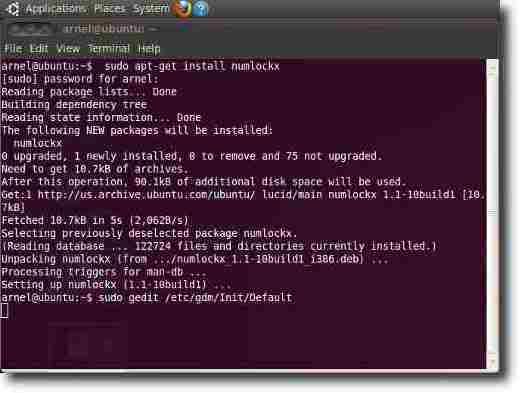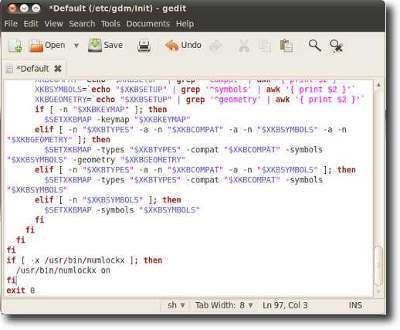skip to main |
skip to sidebar
Ubuntu's Firefox default setting is just annoying: A single click in Firefox address or search bar does not highlight the entry.
Here are the steps to configure Firefox to highlight the entry in the address or search bar.
- In Firefox address bar, type about:config and press Enter.
- Click the “I'll be careful, I promise!” button.
- In the Filter box type browser.urlbar.clickSelectsAll.
- Under Preference Name, double-click browser.urlbar.clickSelectsAll to set it to “true” (or right click and select toggle).
- Close about:config.
Note: If the address or search bar does not highlight on single click, restart Firefox.
I am not comfortable with Ubuntu when changes are to be made through the use of the Terminal. Take for example how to enable the number lock in Ubuntu; to enable number lock you have to write codes in the terminal. Writing codes in Linux is my weakness; thankfully there are plenty of resources that can be found in the Internet to solve every Linux problem.
Here are the steps to enable the number lock key.
1. Click Applications > Accessories > Terminal. A terminal window opens.
2. Type the following code in the terminal and press Enter.
sudo apt-get install numlockx
3. Enter your password when prompted and press Enter.
4. A series of codes run through, wait till the line shows: user_name@ubuntu:~$
 5. Type the following code and press Enter. A gedit window should open.
5. Type the following code and press Enter. A gedit window should open.
sudo gedit /etc/gdm/Init/Default
6. Add the following code before the line exit 0 which is at the end of the code.
if [ -x /usr/bin/numlockx ]; then
/usr/bin/numlockx on
fi
 7. Click Save in the gedit, and close the gedit and terminal windows.
7. Click Save in the gedit, and close the gedit and terminal windows.
To check if this works, turn on the numlock key and restart Ubuntu. If you turn it off before restart, it will only be turned on during logon and turns itself off once Ubuntu is running.
Reference: https://help.ubuntu.com/community/NumLock
Most of us are guilty of this: opening an executable (.exe) without reading the readme instructions for the file.
But there are .exe files that need no double-clicking.
This one made me looked dumb—GIMP’s Save for Web plugin. After extracting the zipped folder of its contents, I opened webexport.exe only to be greeted with a prompt that says that the application has failed because libgdk-win32-2.0-0.dll was not found. This kind of warnings in Windows always freaks me out.
The fact is that, the webexport.exe file needs only to be copied to a personal plugins folder in GIMP—there is no need to double-click it, hence the prompt. Copy webexport.exe and paste it to C:\Documents and Settings\\.gimp-2.6\plug-ins and it’s done.
The screenshot below shows the Save for Web option in GIMP’S File menu once webexport.exe is pasted in the plugins folder.

The Save for Web plugin can be downloaded from GIMP Plugin Registry.
My PC failed to boot into Windows XP or Ubuntu after installing the complete update for Lucid Lynx Gnome (Ubuntu inside XP). With so many attempts to restart, I always get:
Error: no such device: 658965p2-8fg5- . . .
grub rescue>
The best solution
Internet search results showed that this issue of “deleted grub(?)” has been in Lucid Lynx since before it was officially released. To new Linux users like me with little understanding on writing commands, a boot failure is terrifying.
Fortunately, a discussion on restoring the grub bootloader can be found in Ubuntu forums. Ubuntu forums has solutions to restoring XP and Ubuntu—including Vista and Windows 7.
I followed the “How to restore the Windows XP bootloader” method. I booted the PC using the XP installation CD and waited to the part where it asks me to install or repair XP. The following is the procedure I took.
- Press “r” for repair.
- Type 1, when prompted which Windows installation to logon to (1: C:\WINDOWS).
- Type the Administrator password. This was tricky. I typed my logon password but it was rejected. I hit Enter instead, which means the Administrator has no password.
- Type “fixmbr” in the new command line. Ignored the scary warning that the current hard drive would become inaccessible.
- Type “y” for yes to confirm to write a new MBR.
- Type “exit” in the new command line after a new MBR is written.
- Reboot PC.
Problem solved!
Reference: http://ubuntuforums.org/showthread.php?t=1014708
So I installed Lucid Lynx inside XP in an external hard drive. It took 24 hours for me to install Ubuntu Gnome. Not that I was able to install it in one go—Ubuntu was just taking so long to install. It took me about 10 attempts to install it and then cancel the installation because it would stall for no reason.
I wondered what made the installation to stall whenever it was at the part where it is downloading the lucid lynx iso.
Well, I got it right when I did what should be done in installing programs—closed all running programs. So to be sure I restarted my PC and closed all running programs that start automatically during start up, except of course for the anti-virus, firewall. and applications initiated by Windows. It was done in 10 minutes.
As I turned on my external hard drive, the LED light came on. I clicked My Computer in Windows XP and to my horror, the USB hard drive is not there. I checked Device Manager, it’s there but it just shows that it’s a USB storage device and no details. Is this the moment I dreaded that an external hard drive is not reliable and I should have listened to a friend to attached it as an internal hard drive instead?
I checked Administrative Tools, nothing—it’s blank. No sign that XP has recognized it as a device. I restarted my PC, still nothing. Why! when in fact the LED light in the hard drive is turned on. I plugged the USB into a different port—still no success. This is beginning to be a puzzle. I started googling, nada, nothing that would solve my predicament.
But why is the LED light on? Were my files deleted by a hard knock on the hard drive, or did it just vaporize?
I put my hands over the drive’s enclosure. Hmmm . . . no vibrations, I couldn’t feel even a slight hum. Is it the power supply? And why is the LED light turned on?
So I tried to wiggle the female end of the power cord in the hard drive, I felt a whirring sound. Oh, the female end of the power cord is not properly seated. I adjusted it and how wonderfully it worked again! What a fool—all along it was the power cord not seated properly.






